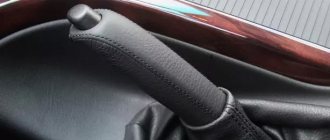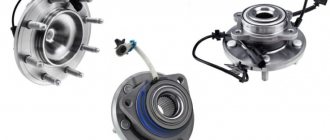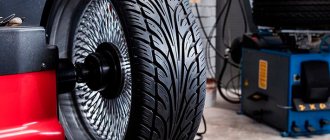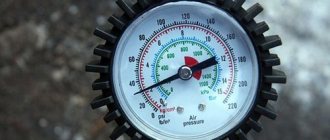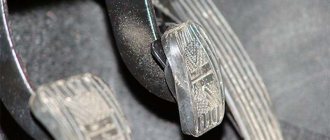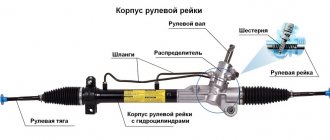14.10.2019
| (Votes: 4, Rating: 5) |
Issues discussed in the material:
- What are the causes of wheel imbalance?
- What are the signs of an unbalanced wheel?
- How often should you have your wheels balanced?
- What to pay attention to when balancing wheels
Every car owner understands why wheel balancing is needed and what will happen if imbalance occurs. However, not everyone can determine whether car wheels are properly balanced, how long they can be driven, and when it is necessary to visit a tire service station. Let's figure out what the signs of an unbalanced wheel are and how to fix this problem.
Causes of wheel imbalance
Unfortunately, many car enthusiasts are negligent about the balancing procedure. You shouldn't do this. After all, the “well-being” of your car depends on how well this procedure is performed.
As the car wheel rotates, it must have:
- axis of symmetry;
- center of gravity, which is located on the axis of rotation;
- points of the circle equidistant from the center of gravity.
Wheel balancing is a procedure to reduce imbalance as much as possible. It is done like this: special granules are added to the rim, which are attracted to the rubber surface. Thanks to this balancing, signs of wheel imbalance are eliminated.
Only when the signs of wheel imbalance are eliminated can you be sure that driving a car will be not only comfortable, but also safe. If you carry out balancing from time to time, you can prevent the occurrence of such unpleasant consequences of imbalance as failure of suspension elements: strut, steering mechanism and bearings.
Wheel imbalance is divided into 2 types:
- Static imbalance. It is observed when the center of gravity is shifted relative to the axis of rotation. The mass is distributed unevenly around the circumference. You may notice vertically directed vibration. As a result, uneven tire wear occurs. Driving such a car is uncomfortable and unsafe.
- Dynamic imbalance. Occurs when the axes of inertia and rotation intersect. The center of gravity is on the axis of rotation. Consequences of dynamic imbalance: unequal distribution of mass across the wheel.
Combined imbalance also occurs. In this case, the axes of inertia and gravity of the wheel are shifted and tilted relative to each other.
Why do signs of imbalance occur:
- the tire is worn out;
- the disc is dented;
- errors in the production of a tire or wheel, for example, the pitch of the tread pattern of a car tire is different, there are holes in the disk;
- side walls of different widths;
- the tires were repaired incorrectly.
We recommend
“Why do you need wheel balancing and when to do it?” Read more
How severe the imbalance will be depends on the condition of the tires. After all, the rubber structure is complex and uneven, all this affects the accuracy of alignment.
Wheel balancing with granules
Today, the most effective way to get rid of imbalances is balancing with granules. The essence of the method is that instead of traditional weights, special granules are poured into the tire, which easily slide along the inner surface of the rubber. During rotation, rolling, they correct the process of mass distribution, thereby eliminating the imbalance of the wheel as a whole.
The advantages of this method are obvious, since the granules are poured once and, as a rule, are enough for the entire service life of the tire. Unlike the same weights, which very often fly off, granules are always inside and perform their tasks. The only reason why this technique has not yet received widespread recognition is the relatively high cost of the service.
To summarize, we once again draw the attention of car owners to the fact that wheel balancing is not a whim, but a mandatory procedure that must be carried out regularly to increase the service life of suspension elements and the tires themselves.
Signs of an unbalanced wheel
What is the most common sign of imbalance? Of course it's vibration. When there is an imbalance, vibration comes from the chassis of the car into the interior. The greater the imbalance, the worse the road and the higher the speed of the car, the stronger the vibration will be. Vibrating movements are different. For example, you may hear a slight noise, or the car may shake so much that driving becomes uncomfortable.
You can find out which car wheel is unbalanced if you distinguish between different types of vibrations. For example, you are driving a car and most of all you feel vibrations that go to the steering wheel. This means that there is an imbalance of the front wheels. When the rear wheels are unbalanced, unpleasant shaking will be felt by passengers riding behind.
Why does wheel imbalance occur and what are its symptoms? During rotation, certain areas of the tire experience greater pressure than other areas. Due to the fact that the car wheel moves unevenly, vibrating vibrations occur. Areas of the tire that are exposed to higher pressure quickly wear out and become weaker. If there are signs of an unbalanced wheel that has worn out in certain places, the rubber will begin to deflate and you will have to constantly pump up the tires.
What other signs of imbalance are there? For example, you notice that your car suddenly begins to consume more fuel. Most likely the reason is imbalance. The stronger it is, the more fuel the car consumes. This is especially noticeable when you are driving at high speed.
What can happen if you ignore signs of imbalance:
- Driving by car will not only be uncomfortable, but also dangerous.
- The steering will fail.
- The shock absorbers will fail.
- Bearings and other suspension elements will become unusable.
The reason for such unpleasant consequences is vibrating vibrations that arise due to imbalance and affect the car.
Note!
If you notice the steering wheel wobbling, it may not only be a sign of imbalance. It hits the steering wheel if the disc is dented, the tire has hernias, the cord is damaged, etc. However, if the wobble only occurs when you increase the speed, then this is 100% a sign that the front wheel is unbalanced. In this case, it doesn’t matter at all whether the car is rear-wheel drive or front-wheel drive. If there is an imbalance of the rear wheels, then such a sign as steering wheel beating does not appear.
Most often, signs of an unbalanced wheel are observed when changing winter tires to summer tires (or vice versa). Car owners do not think about what equipment is used for balancing and whether the technician is experienced. But the quality of the procedure depends on this. For example, an imbalance may appear after 200–300 km if the balancing specialist has not washed the tires. Chunks of dirt will fall off and you will again see signs of wheel imbalance.
If a low-quality weight was used, the steering wheel may wobble. After all, under the influence of centrifugal force, the weight will come off and start hitting the steering wheel.
How to spot signs of imbalance? Raise the car with a jack, and then install a balanced wheel and check. Then, by following a few simple steps, you will discover the signs of an unbalanced wheel, if any.
- Take a piece of chalk in your hands and spin the disc.
- When it stops, use a chalk mark to mark the center of the wheel arch.
- Spin the disc a few more times, preferably 6–10.
- Are the marks made collected at approximately one point? This is a sign of imbalance. You need to go to a tire shop as soon as possible.
We recommend
“How often to balance wheels with and without rims” More
Chalk marks are not collected at one point, but are scattered throughout the tire? There are no signs of imbalance, and there is no need to spend money on balancing.
How often should you have your wheels balanced?
When you have one set of rims for both winter and summer, you will have to carry out balancing. Otherwise there will be signs of imbalance. Only those motorists who have 2 sets of rims: for winter and for summer, can think about whether it is worth doing balancing.
Is wheel balancing necessary after a seasonal tire change?
Let's refer to the vehicle's operating instructions. It should indicate that balancing must be performed every 10,000–15,000 kilometers. Is your seasonal mileage less? Then theoretically no balancing is required, except for the situations described below.
However, in reality, you need to focus on the “well-being” of the car. Are there any obvious signs of an unbalanced wheel, such as shaking in the steering wheel? This means that you can do without balancing. It is not always possible to feel the beating of the rear wheels, but they are not negatively affected as much. One way or another, knowing the signs of imbalance, you can determine whether you need to visit a tire shop.
What if a car owner changes the tires himself twice a year? Follow the tips below. Install a new set of car wheels and drive them for a few days. During this time, the deformation on the rubber that occurred during storage will disappear. There are no signs of an unbalanced wheel, no vibrations, and it doesn’t matter how fast or slow you are driving? This means that balancing is not needed.
However, this procedure cannot be avoided if:
- the seasonal mileage of your car is more than 15,000 km;
- after the car wheel was balanced, you drove into a hole at high speed;
- felt a slight vibration earlier, but did not perform balancing;
- your car does not have ABS, and you often brake while skidding on the asphalt;
- you have little driving experience and cannot identify signs of imbalance.
What is wheel balancing and why is it needed?
Balancing means combining the geometric and actual centers of mass of the wheel. In simple terms, the geometric center of mass is the theoretical axis passing through the central hole. In practice, the actual center of mass almost never coincides with the central axis, but is located at some distance from it. The distance between these two points is called eccentricity. The discrepancy is due to the fact that the thickness of the tire in different areas can be different, in addition, the spool has additional weight, and the disk itself has slight differences in weight.
During rotation, moments of inertia arise that interfere with uniform circular motion, creating radial and axial runout. The magnitude of the moment of inertia depends on the unbalanced mass and the distance to the geometric axis. The only way to get rid of imbalance is to balance the free mass, aligning the axes of rotation and the center of mass.
Based on the above, we can safely say that the main task of wheel balancing is to eliminate radial and axial runout by compensating for mass by adding special weights or in some other way.
Consequences of wheel imbalance:
- Uneven wear of tires, due to which not only the handling deteriorates and the dynamic properties of the car decrease, but also the wear of the tires themselves significantly increases.
- Increased loads on parts and suspension units. As a rule, the first to fail are wheel bearings, which experience colossal radial loads due to wheel imbalance. A faulty bearing can jam at any time, which is especially dangerous at high speed. The steering ends will also not last long.
- Unpleasant noises and vibrations arise, which are transmitted to the steering wheel, as a result, controllability deteriorates and the level of comfort drops significantly. Driving a car with a vibrating steering wheel is a real punishment.
How often should you balance?
It should be noted that balancing must be carried out even when purchasing new disks, since there are often cases when a new product has a significant imbalance. Also, checking the absence of radial and axial runout should be carried out every 10-15 thousand kilometers. However, if during this period any emergency situations arose, for example, there was a collision with a curb or a wheel fell into a hole at speed, you must do an unscheduled check as soon as possible.
Errors when balancing wheels
So, you discovered signs of an unbalanced wheel and went to a tire shop. How to determine that a master is doing his job poorly?
- The specialist did not wash the tires and wheels . Most often, an unscrupulous technician does not wash car wheels. At first glance, it may seem that this procedure is not that important. But if there is dirt on the tires and rims, they will not be balanced. After all, even a ten-gram piece of dirt on a wheel, or a small pebble that gets stuck in the tire tread, can cause imbalance. And when you drive at a speed of 100 kilometers per hour, the steering wheel will begin to hit, and the suspension elements will begin to experience an unintended load, ultimately leading to destruction.
- The balancing machine is not securely fastened.
Another reason why a wheel may become unbalanced is that the balancing machine is not positioned correctly. They can simply put it in a trailer on a wooden surface. But such a machine must be attached with anchor bolts to a flat concrete floor. There should be no vibrations. Otherwise, the master will not be able to perform balancing efficiently. You should not visit mobile tire shops, because there will be no benefit from such balancing. - The technician did not calibrate the balancing machine .
According to the rules, balancing equipment must be calibrated several times a season. However, in many tire shops, whose owners are not concerned about the quality of the services provided, this procedure is not carried out. In addition, it is impossible to calibrate an expensive machine on your own. In order not to waste money on the work of a third-party specialist, sometimes calibration is not carried out. - The master glued the balancing weight poorly.
If the rims are alloy, then the balancing weights are usually glued on. To prevent it from coming off due to vibrations or moisture during car washing, it is necessary to properly prepare both the weight and the disk. Before gluing the weight, you need to wipe the disk with a degreasing compound, such as solvent. Moreover, the disk must be cleaned of dirt in advance. The area where the weight will be glued, and the weight itself, are heated with a construction hairdryer.We recommend
“Final balancing of wheels: a marketing ploy or a useful procedure” Read more
This is the correct operating technology; if it is followed, the weight will never come off, even if water gets on the wheel at a car wash. But, unfortunately, the technology of the procedure is often violated, so at car wash stations you can see a lot of weights that have come unstuck. - The master does not perform balancing “at zero”.
The specialist is in a hurry or lazy, he tells you that nothing bad will happen, even if there is 5 g of imbalance. But when the disc is mounted on the car, signs of imbalance will appear. That is why it is important that after balancing, zero deviation indicators of balance indicators outside and inside the wheel are displayed on the bench monitor.To achieve this result, you will have to peel and re-stick the weights several times. Maybe the technician will even disassemble and clean the inside of the wheel if there is any water or dirt left there. Or the disk is bent, in which case it needs to be straightened. In any case, there should be no errors. Even a minimal imbalance of 5 g will cause the steering wheel to wobble at high speed, the car will handle worse, and the suspension elements will quickly fail.
- The master uses a wrench to tighten the wheel..
Working with a wrench, the technician spends less time and effort, but driving a car after such a service becomes unsafe. The fact is that a wrench can ruin the threads on studs, nuts and bolts. As a result, there is a threat to the lives of the driver and passengers. If the technician over-tightens the nuts and bolts, the wheel seat will become distorted and you will again experience signs of an unbalanced wheel.Even though the technician can use the impact wrench carefully, the bolt or nut will still be overtightened. And when you want to unscrew the wheel on the track, you will not be able to do it. Only the newest tire centers use special impact wrenches, which can be used to make the force minimal. At the end of the work, the master uses a torque wrench to tighten the nuts to the required torque. Remember that you can use a wrench to unscrew, not tighten, nuts.
- The specialist tightens the bolts or nuts on the disk in a circle .
In this case, the alignment of the car wheel relative to the hub will be disrupted. As a result, signs of an unbalanced wheel will again appear. The hub, as well as the suspension elements, will experience increased loads. How not to lose alignment? To do this, tighten the nuts and bolts crosswise. - The technician does not use a torque wrench and tightens the nuts incorrectly, with too much force..
It often happens that when installing a wheel, the master tightens the nuts, focusing on his feelings and experience. Or uses a wrench. Since the disc material is quite soft, due to the fact that the nuts are unevenly tightened, they become crooked and signs of imbalance appear. How to tighten bolts and nuts on a wheel? A torque wrench is used to perform this procedure. With its help, you can tighten it with the required force, which differs depending on the make and model of the car. You can find out what the force should be for your car in the vehicle’s operating instructions.It is worth noting that the standard wheel key, which is located in the luggage compartment of your car, has such dimensions for a reason. The size of the wrench should be such that, by kneeling and pressing with your hands (without attaching a pipe to the wrench or pressing on it with all your might), you can tighten the nuts on the wheel with the required force. It does not matter whether a man or a woman performs this procedure.
You should be able to unscrew the wheel just as easily with a standard wheel wrench. Of course, if at the tire fitting the specialist used a torque wrench and did not tighten the nuts.
Final wheel balancing
A similar event is carried out after the basic wheel balancing has been performed. The main goal of final balancing is to reduce the difference in mass to zero, thereby almost completely eliminating the effect of imbalance. Final balancing is usually carried out on vehicles that are often driven at high speeds. A good result can be obtained by replacing traditional lead weights installed on the rim with modern granules that are poured directly into the tire. To carry out final balancing, you need high-tech equipment that creates a specific three-dimensional model and performs its subsequent detailed analysis.
What do drivers think about wheel imbalance?
- Trust but check . “Six months ago, an acquaintance advised me (after balancing was done at a tire shop) to put the wheel on the machine and spin it. After such a check, I was shocked. Before removing the wheel, the indicators were “zero”; when the master removed the wheel, and I asked to put it back on, the indicators after balancing were 10–50 g! The would-be specialist realized too late what the purpose of this check was.”
- You can't do it without adapters .
“I read in one authoritative auto magazine that it is possible to properly balance wheels only if adapters are used that play the role of a car hub. This way, the disc fits onto the studs and not onto the cone.” - If it hits the steering wheel, this is not a sign of imbalance.
“As for runout, my car has soft Yokohama tires, 18-inch wheels, and the suspension is quite stiff. It does not hit the steering wheel, even if the imbalance is 35 g. There is one sign of imbalance: when I smoothly brake at a speed of 100 km/h, a beating occurs. But at a speed of 150 km/h there is no beat when braking.”We recommend
“Why do rubber wear out and how to extend the life of tires” Read more
- You need to focus on the beat .
“Before gluing the weights, you need to set the tires on the rims according to the runout. When the wheel rotates, the runout is visible in height. In this case, you need to turn the tires on the disk so that it hits less. Then you will have to use a lot more weights. But this is not profitable for tire fitters. Another piece of advice: when you have balanced a new wheel, you should balance it again after 1,000 km, when the rubber rests on the rim and there are definitely no signs of imbalance.” - You can only trust an experienced tire fitter .
“We can talk on this topic endlessly. My assembled wheels from Japan have been used for 2 seasons, no signs of imbalance have appeared. And when the master balances the wheels poorly, steering wheel wobble appears. It’s not so easy to find an experienced specialist today.”
What are the dangers of improperly balancing car wheels?
16.04.2019
The season for replacing winter tires with summer tires is approaching in the Urals. As a rule, it is accompanied by wheel balancing, as a result of which the mass of all components of the wheel is evenly located relative to the axis of its rotation. After this procedure, the wheel must be balanced vertically and horizontally. If balancing is incorrect, both static and dynamic imbalance can occur, which leads to vibration, which has an extremely negative impact on the strength of parts and driving safety.
“One of the most dangerous consequences of unbalanced wheels is loss of control over the car during high-speed driving. In many tragic accidents, this could be the main reason for driving into the oncoming lane or skidding,”
- explains
Maxim Pozolotin, head of the department for ensuring the uniformity of measurements of mechanical and vibroacoustic quantities of the Federal Budgetary Institution "URALTEST" .
Vibration transmitted to the tires leads to the fact that the contact patch of the wheel with the road surface loses stability, the quality of road grip is significantly reduced, as a result, the braking distance increases, and its direction becomes unpredictable. In addition, the car “listens” worse, and while driving there are often situations when there are only fractions of a second to correct the situation.
“It is often very difficult to establish a direct cause-and-effect relationship between a traffic accident, a serious vehicle breakdown and improper wheel balancing, since its consequences are significantly delayed in time
“, reports
Maxim Pozolotin
.
For example, the destruction of a wheel bearing occurs gradually - due to vibration caused by wheel imbalance, loads arise on this and other suspension parts that are many times greater than the calculated ones, which invariably leads to their accelerated wear. It’s good if the car enthusiast gets away with only a very expensive replacement of the bearing, but a much sadder outcome can happen - a wheel coming off while driving turns the car into an uncontrollable pile of metal even at low speeds.
Another delayed consequence of improper balancing is uneven tire wear, which after 1-2 seasons takes on the shape of an egg. In addition to deteriorating road grip, this leads to the fact that tires have to be changed more often. The stress that the driver experiences when the steering wheel “beats”, when the car pulls to the side, or when controllability is generally reduced, also negatively affects driving safety.
“Let’s give one simple example - if the imbalance of the
R 15 wheel is 25-30 grams, then at a car speed of 100 km/h, loads equivalent to impacts weighing 3 kg with a frequency of 700-800 times per minute will act on the suspension and chassis elements “,
” says
Pavel Baranovsky, head of the sector for verification of measuring instruments in transport, department of ensuring the uniformity of measurements of mechanical and vibroacoustic quantities of the Federal Budgetary Institution “URALTEST”.
How to choose a tire shop that provides proper wheel balancing? The high price of services is only an indirect sign of high-quality work. The only guarantee that the procedure will be carried out correctly is the presence of a certificate of verification of the balancing stand and the completion by a specialist of all the necessary sequence of actions.
Balancing stands are a measuring instrument, and most models are included in the State Register of Measuring Instruments on the basis of a document - a description of the type of measuring instrument, in which the verification interval is set at 1 year.
Many tire shop owners neglect verification, claiming that for normal operation, calibration or auto-calibration, which is included in the functionality of the device, is sufficient. However, with this method of adjustment, the stand compares the readings with itself, while verification ensures their comparison with the standard.
“During the verification process, a perfectly balanced plate and reference weights are installed on the balancing stand, the balancing process is simulated, and using a certain method it is checked how the device recognizes the given values, as a result of which all existing deviations can be determined.”
, says
Pavel Baranovsky
.
An unverified balancing stand takes the accumulated instrumental error as zero and transmits obviously erroneous data to the wheel. Since the negative consequences of imbalance do not occur here and now, and verification of the balancing stand is voluntary, unscrupulous owners of tire shops are well aware that it is almost impossible to hold them accountable in the event of serious problems. Therefore, concern for the good condition of the car, their own safety and the safety of their children falls on the owner of the vehicle, because a penny saving on tire fitting can turn into, if not a tragedy, then expenses for expensive repairs. The presence of a verification certificate for a balancing stand and other measuring instruments indicates that the head of the enterprise understands the importance of such a seemingly simple service as wheel balancing and is interested in its high-quality provision.



